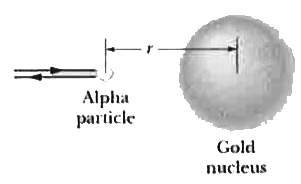An alpha particle ( two protons, two neutrons) moves into a stationary gold atom (79 protons, 118 neutrons), passing through the electron region that surrounds the gold nucleus like a shell and headed directly toward the nucleus (Fig. 24-42 . The alpha particle slows until it momentarily stops when its center is at radial distance r=9.23 fm from the nuclear center. Then it moves back along its incoming path. (Because the gold nucleus is much more massive than the alpha particle, we can assume the gold nucleus does not move.) What was the kinetic energy Ki of the alpha particle when it was initially far away (hence external to the gold atom)?. Assume that the only force acting between the alpha particle and the gold nucleus is the (electrostatic) Coulomb force and treat each as a single charged particle.

During the entire process, the mechanical energy of the alpha particle + gold atom system is conserved.
Reasoning: When the alpha particle is outside the atom, the system.s initial electric potential energy Ui is zero because the atom has an equal number of electrons and protons, which produce a net electric field of zero. However, once the alpha particle passes through the electron region surrounding the nucleus on its way to the nucleus, the electric field due to the electrons goes to zero. The reason is that the electrons act like a closed spherical shell of uniform negative charge and, as discussed in Section 23.4, such a shell produces zero electric field in the space it encloses. The alpha particle still experiences the electric field of the protons in the nucleus, which produces a repulsive force on the protons within the alpha particle.
As the incoming alpha particle is slowed by this repulsive force, its kinetic energy is transferred to electric potential energy of the system. The transfer is complete when the alpha particle momentarily stops and the kinetic energy is Kf=0.
Calculations: The principle of conservation of mechanical energy tells us that
Ki+Ui=Kf+Kr (24-63)
We know two values: Ui=0andKf=0. We also know that the potential energy Uf at the stopping point is given by the right side of Eq. 24−61, with q1=2e,q2=79e (in which e is the elementary charge, 1.60×10−19C), and r=9.23 fm. Thus, we can rewrite Eq. 24−63 as
Ki=14πε0(2e)(79e)9.23fm
=(8.99×109N.m2/C2)(158)(1.60×10−19C)29.23×10−15m
=3.94×10−12J=24.6MeV. (Answer)
Topper's Solved these Questions
- ELECTRIC POTENTIALBOOK - RESNICK AND HALLIDAYCHAPTER - ELECTRIC POTENTIALEXERCISE - SAMPLE PROBLEM 24.23 Finding potential on spherical conducting shell due to point charge kept outside the shell
1 Videos
- ELECTRIC POTENTIALBOOK - RESNICK AND HALLIDAYCHAPTER - ELECTRIC POTENTIALEXERCISE - SAMPLE PROBLEM 24.24 Potential due to charges on three concentric shells
1 Videos
- ELECTRIC POTENTIALBOOK - RESNICK AND HALLIDAYCHAPTER - ELECTRIC POTENTIALEXERCISE - SAMPLE PROBLEM 24.21 Potential energy of a system of three charged particles
1 Videos
- ELECTRIC CHARGES AND FIELDSBOOK - RESNICK AND HALLIDAYCHAPTER - ELECTRIC CHARGES AND FIELDSEXERCISE - Practice Questions (Integer Type )
3 Videos
- ELECTROMAGNETIC INDUCTIONBOOK - RESNICK AND HALLIDAYCHAPTER - ELECTROMAGNETIC INDUCTIONEXERCISE - PRACTICE QUESTIONS (Integer Type)
14 Videos
Similar Questions
In a head on collision between an alpha particle and gold nucleus (Z=79), the distance of closest approach is 39.5 fermi. Calculate the energy of α-particle.
View SolutionIn a head on collision between an alpha particle and gold nucleus (Z=79), the distance of closest approach is 39.5 fermi. Calculate the energy of α-particle.
View Solution
Knowledge Check
When a β-particle is emitted from a nucleus, the neutron-proton ratio
Ais decreasedBis increasedCremains the sameDfirst decreases and then increasesWhen a β− particle is emitted from a nucleus, the neutrons-proton ratio:
Ais decreasedBis increasedCremains the sameDfirst (A) then (B)In a geiger - marsden experiment. Find the distance of closest approach to the nucleus of a 7.7 me v α- particle before it comes momentarily to rest and reverses its direction. (z for gold nucleus = 79) .
A10 fmB20 fmC30 fmD40 fm
When a β− particle is emitted from a nucleus, the neutrons-proton ratio:
View SolutionWhen a β− particle is emitted from a nucleus, the neutrons-proton ratio:
View SolutionIn a head-on collision between an α-particle and a gold nucleus, the minimum distance of approach is 3.95×104m. Calculate the energy of the α-particle.
View SolutionIn a Rutherford scattering experiment, assume that an incident alpha particle (radius 1.80 fm) is headed directly toward a target gold nucleus (radius 6.23 fm). What energy must the alpha particle have to just barely "touch" the gold nucleus?
View SolutionIn a geiger - marsden experiment. Find the distance of closest approach to the nucleus of a 7.7 me v α- particle before it comes momentarily to rest and reverses its direction. (z for gold nucleus = 79) .
View Solution
